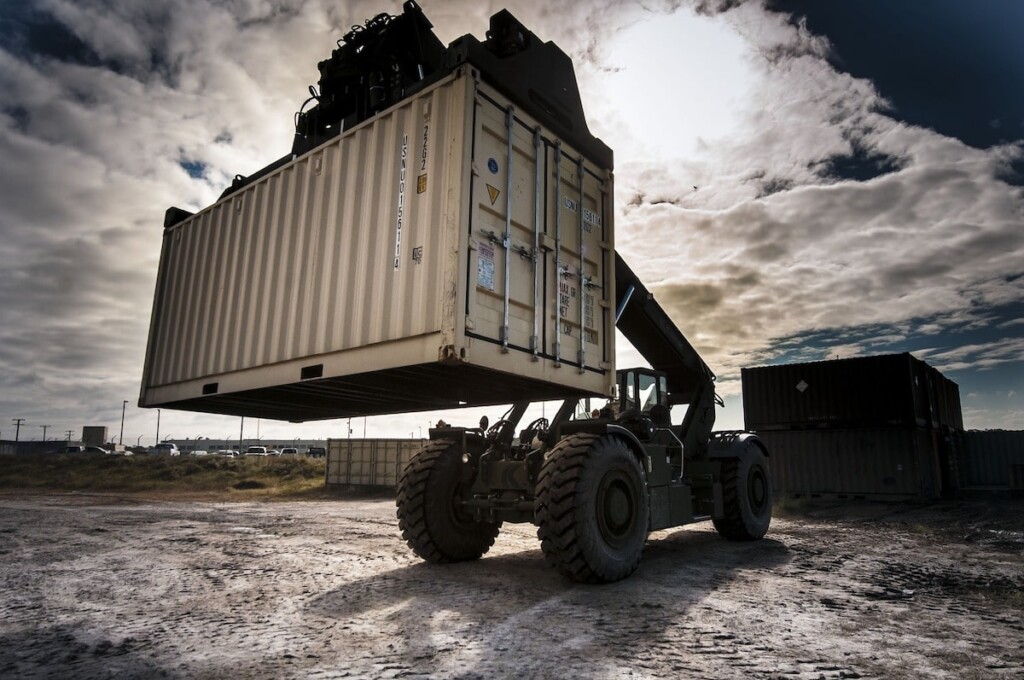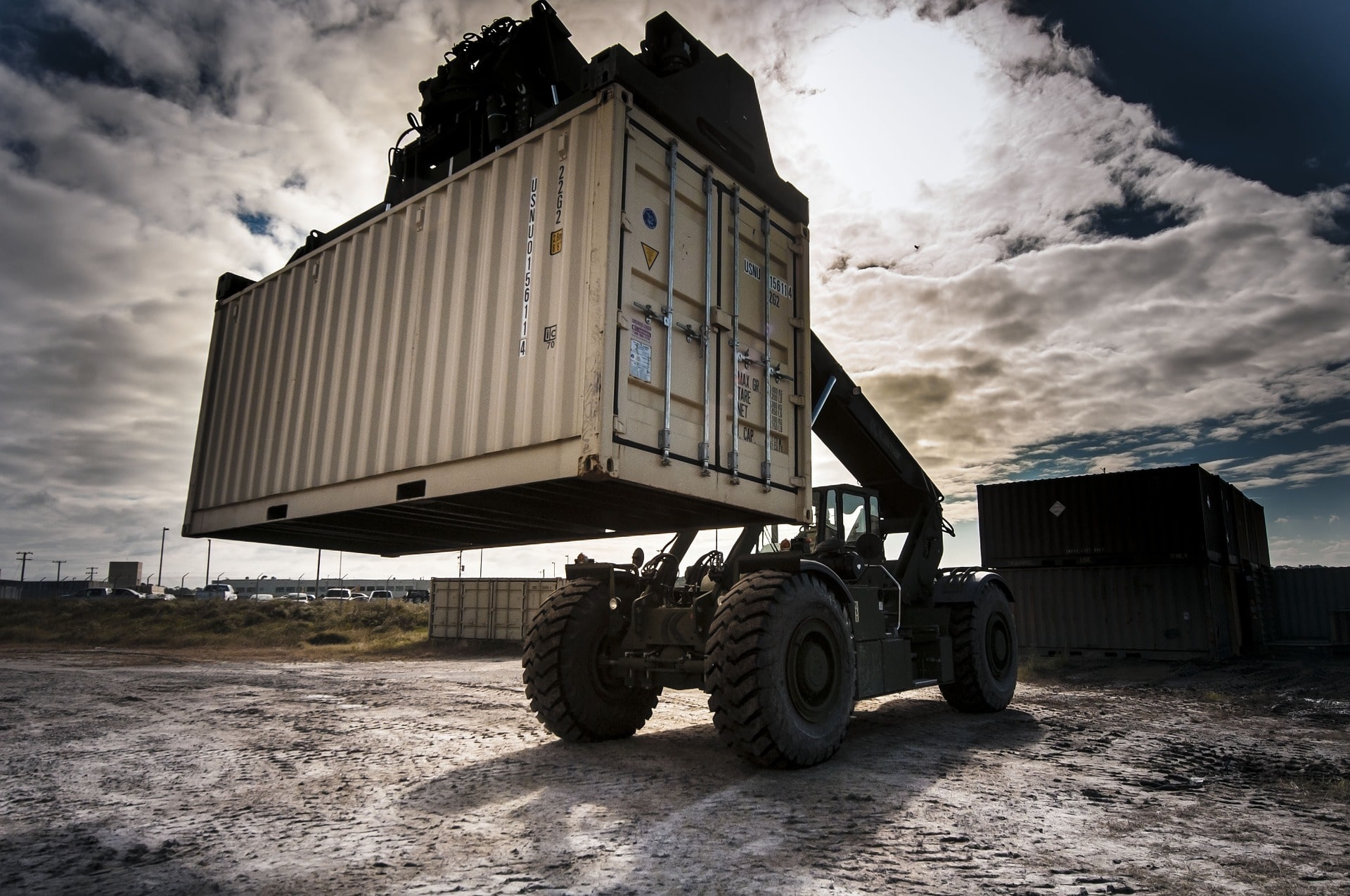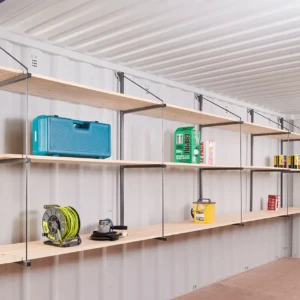Moving a shipping container may seem like a big job, and to be honest, it can be. But with a bit of planning, the right equipment, and a few good tips, it’s doable without breaking your back (or the bank). Whether you’re relocating a container across the yard or across town, this guide will walk you through everything you need to know, step by step, to do it safely, efficiently, and with as little stress as possible.
Before You Get Started – A Few Things to Keep in Mind
- Do a little prep work upfront. Take time to inspect both the container and the spot where it’s going. Trust me, this simple step can save you a ton of trouble later.
- Pick the right tool for the job. Whether you’re using a tilt trailer, a forklift, a crane, or just a heavy-duty truck, the best option really depends on how far you’re moving it, how easily you can access the site, and the size of your container.
- Secure it like you mean it. Straps, chains, or twist locks, whatever you use, make sure that the container isn’t going anywhere during the move. A little extra effort here goes a long way in avoiding damage (or disaster).
- Budget wisely. Moving costs can vary a lot. Things like distance, equipment, permits, and even insurance come into play. And if you’re in a place like Texas, you’ll want to be extra mindful of any transport rules or state-specific red tape.
Moving a Container Cheat Sheet
This table will help you quickly identify the best equipment for your situation based on factors like weight capacity and terrain adaptability.
| Equipment Type | Weight Capacity | Cost Estimate | Terrain Adaptability | Best Use Cases |
| Forklift | Up to 15,000+ lbs | Moderate | Limited | Short-distance moves, tight spaces |
| Crane | Up to 60,000+ lbs | High | Adaptable | Heavy loads, challenging access points |
| Tilt Trailer | Varies by model | Affordable | Flat surfaces only | Cost-effective, short-distance moves |
| Side-Loader Truck | Varies, generally under 20,000 lbs | Moderate to High | Urban and tight spaces | Efficient for direct site unloading |
| Roll-Off Truck | Typically lighter loads | Moderate | Limited to even terrains | Temporary sites, frequent moves |
Moving a Shipping Container Step by Step
1. Check the Container and Site
Check for rust, dents, or any damage, especially around the four corners and door hinges; these spots take the most stress when lifting.
Now check the site:
Look for uneven ground, slopes, or anything that might get in your way.
Watch out for: Overhead power lines. You’d be surprised how many people forget to look up before bringing in a crane.
2. Prep Your Container for the Transport
Secure everything inside:
Use cargo bars, wooden bracing, or straps to keep your stuff from shifting. Got fragile or valuable items? Add some padding or foam to soften bumps along the way.
Lock the doors: Sounds obvious, but it’s easy to forget in the rush.
Common Mistake: If the doors swing open mid-transport, you’re in for a real mess.
3. Lift and Load the Container Safely
Line up your equipment first: Whether it’s a crane, forklift, or tilt trailer, make sure everything’s in place and ready to go. Use chalk or markers on the ground for perfect alignment.
Use the right lift for your setup:
- Cranes: Hook onto the corner castings and lift slowly, evenly. No swinging allowed.
- Forklifts: Center those forks with a wide base for stability.
- Tilt Trailers: Back up straight and hook on before tilting.
4. Secure the Container for Transport
Secure the container to your vehicle: Use heavy-duty chains, ratchet straps, or twist locks. Give everything a good tug. If it wiggles, it’s not tight enough.
Double-check before you roll out: Make sure every hook, strap, and fastener is snug and strong.
Using flimsy straps or skipping a final check can lead to a shifting load, and that’s no fun to deal with on the road.
5. Transporting the Container
Know your route: Watch out for low bridges, tight turns, and weight restrictions. You might also need permits, especially in states like Texas. Call ahead if you’re unsure; cities don’t always post permit requirements clearly online.
Drive with care: Keep your speed steady and take your turns smoothly.
Sharp corners or sudden stops can cause the container to tip or slide.
6. Unload The Container
Park on level ground: Slopes = trouble. Use wheel chocks to keep everything still while you unload.
Unfasten carefully: Take your time releasing chains or straps, and ensure no one is standing too close.
7. Final Walkthrough
Inspect your container: Look for new dents, scrapes, or shifted items inside. Snap a few photos before and after. Handy for insurance or just peace of mind.
Secure it in its new spot: If the ground is soft or uneven, add blocks or supports to keep it steady.
Thinking “it looks fine” is good enough. Containers can shift or settle over time, especially in wind or rain.
One Last Thing…
If things get stuck on soft ground, uneven terrain, or during lifting, stop immediately. Don’t try to yank or force it with your vehicle. That’s how accidents (and broken equipment) happen.
Use the right gear to unload:
- Tilt trailers: Ease it down slowly.
- Forklifts/cranes: Lower it just as steady as you lifted.
How to Move a Shipping Container Over Short Distances
Here’s a breakdown of the most common tools folks use for short-distance container moves (and how to know which one’s right for you).
Using a Crane
If your container is in a challenging location, such as behind a building or on uneven ground, a crane may be your best option. These machines lift straight up and set the container precisely where you want it, eliminating the need for dragging or bumping around.
What You Need to Know:
- Truck-Mounted Cranes: Ideal for on-site lifts, especially when you need to place a container onto a trailer.
- Gantry Cranes: Bigger jobs, heavier containers. These are stable and strong for lifting major weight.
- All-Terrain Cranes: Best for remote areas or rough land where most trucks wouldn’t dare go.
Cranes can lift up to 60,000 pounds and reach awkward spots, but they do need plenty of setup space for those stabilizing legs.
Using a Forklift
Got to shift a container across a job site or yard? A heavy-duty forklift can do the trick as long as it’s strong enough.
Good to Know:
- Standard forklifts won’t suffice; you’ll need one rated for 15,000 pounds or more.
- Perfect for short, controlled moves on flat, even ground.
- Handy for precise placement, like setting the container onto a flatbed or nudging it into just the right spot.
Uneven ground and heavy containers are a dangerous mix. Always bring in a certified operator who knows what they’re doing.
Using a Truck

If you’re hauling your container across town or even a few hundred miles, a truck is the workhorse you’re looking for.
Your Truck Options:
- Flatbed Trucks: A tried-and-true method for longer hauls. Just load it up (usually with a crane or forklift) and hit the road.
- Chassis Trucks: Built specifically for shipping containers, these make loading and unloading simple.
- Side Loaders: Not great for rough roads, but handy when space is tight and you need to lift from the side.
- Roll-Off Trucks: Don’t want to mess with cranes or lifts? Roll-offs let the container slide off the back. Super convenient for job sites and local moves.
Using a Tilt Bed Trailer

For local jobs or backyard moves, tilt trailers are a great choice. These handy rigs use hydraulics to gently lower or raise the container without needing extra equipment.
Here’s Why People Love Them:
- Simple Loading/Unloading: No crane or forklift is needed; simply tilt and slide.
- Perfect for Short Moves: Consider distances under 200 miles, or even just within your property.
- Budget-Friendly: Less equipment means lower costs. Just be sure the ground’s flat enough to handle it.
These are great for solo jobs or tight areas where larger equipment can’t be accessed.
Using a Tractor
If you’ve got access to a tractor with the right setup, you’re in luck. Many folks use tractors paired with a custom trailer or chassis to move containers over short and mid-range distances with ease.
- Works great on rural land, farms, or remote job sites.
- Gives you control without needing to hire out a whole crew or big machinery.
Always double-check that your trailer or chassis is rated for the weight of a full container and that it’s secured before hitting the road.
How to Move a Shipping Container Over Long Distances
If your container needs to go farther than just across town or even across the country, there are a couple of solid ways to get the job done. For big moves, rail and sea transport are the go-to methods. Let’s break it down.
Rail Transport: A Reliable Workhorse for Long Hauls

Moving a container by rail is a smart option when you’re covering serious ground. Trains are built for this kind of job. They’re efficient, cost-effective, and made to haul heavy loads without breaking a sweat.
How It Works:
- Your container is lifted onto a specialized container train at a rail yard.
- It rides the rails to a new city, port, or hub, often faster and cheaper than a truck.
- From there, it’s offloaded and delivered to the final location by truck, trailer, or tilt bed.
Tip: Rail works best when you’re near a freight terminal and don’t need doorstep delivery.
Ship Transport: When Your Container’s Going Overseas

Got a container that needs to cross the ocean? That’s where container ships come in. These massive vessels are designed to carry hundreds, sometimes thousands, of containers at a time.
Why It Works:
- Ships are the most practical means of moving containers internationally.
- Containers are stacked securely in rows and ferried across the sea from port to port.
- Once it arrives, a crane unloads it and it’s transferred to a local rail or trucking company.
Be sure to check customs paperwork and container prep if you’re shipping internationally. A little prep now saves a lot of hassle later.
Can I Move a Shipping Container Myself?
Sure, with the right equipment, such as a rented tilt trailer or a heavy-duty forklift, you could move it on your own. But here’s the catch: containers aren’t exactly light. A standard empty one can weigh over 5,000 pounds, and things can go wrong quickly if it’s not done correctly.
Here’s what you’d need to consider:
- Proper tie-downs: You’ll need to secure that container tightly so it doesn’t shift or tip.
- Legal road limits: Not all roads (or bridges) can handle the size or weight.
- Insurance: You’ll want to be covered in case anything goes wrong during the move.
- Licensing: In most places, driving a rig hauling a full-size container requires a commercial driver’s license.
Unless you’ve got hands-on experience with heavy machinery and know your way around DOT rules, your best bet is to hire a transport company. They’ll bring the right tools, handle the permits, and make sure your container gets from A to B safely.
How Much Does It Cost to Move a Shipping Container?
Like many large projects, the cost of relocating a shipping container depends on the tools, distance, and the level of assistance required. According to Angi, the average cost is approximately $3,000, but it can range from $2,000 on the low end to over $ 5,000 for larger or more complex moves.
To help you get a better idea of what to expect, here’s a simple breakdown of the most common options and what they’ll run you.
Forklift Rental

- Cost Range: $200–$600 per day (depends on lifting capacity and rental company)
- Extras to Watch For: Some locations require hiring a certified operator, which incurs an additional $50–$100 per hour.
Crane Services
- Cost Range: $500–$1,500 per hour
- Typical Job Time: Plan for at least 2 hours minimum
- Extras to Expect: Rigging and setup can tack on $200–$500. And if you’re in a remote area, travel fees may also be applicable.
Tilt Trailer Rental
- Cost Range: $100–$300 per day
- Extras to Consider: If you don’t already have a heavy-duty tow vehicle, renting one may cost $75–$150 per day. Don’t forget to factor in fuel!
Side-Loader Truck Services
- Local Moves: $400–$800
- Longer Moves: Around $1,500
- Other Costs: These usually include the operator, but going more than 50 miles? Expect fuel surcharges.
Roll-Off Truck Services
- Local Moves: $300–$600
- Extra Moves or Time: Add $100–$200 per extra pickup or drop-off, or if you keep the truck longer than expected.
If you’re in Texas, there are a few additional steps to follow. State laws require special permits for oversized loads and proof of insurance to cover any damage or liability. It’s nothing too scary, just something to plan for.
What Are the Dimensions and Weight of Standard Shipping Containers?
| Container Type | Length | Width | Height | Empty Weight | Max Gross Weight |
| 10-Foot | 10 ft | 8 ft | 8’6″ | ~2,200 lbs | ~22,000 lbs |
| 20-Foot Standard | 20 ft | 8 ft | 8’6″ | ~4,800 lbs | ~52,000 lbs |
| 40-Foot Standard | 40 ft | 8 ft | 8’6″ | ~8,200 lbs | ~67,200 lbs |
| 40-Foot High Cube | 40 ft | 8 ft | 9’6″ | ~8,600 lbs | ~67,200 lbs |
How Long Does It Take to Move a Shipping Container?
If you’re just moving your container across town or even within your property, you’re usually looking at a few hours, at most, including loading and unloading. It’s a half-day project if everything goes smoothly.
Now, if that container’s going a bit farther, say across the state or out of town, give it 1 to 5 days. The timeline depends on a few things, like:
- How soon will the truck or trailer be available
- Whether you need permits (some states require them for oversized loads)
- And the wild card: traffic or weather
Want to speed things up? Have the site ready, the container accessible, and the equipment lined up ahead of time. That alone can shave hours off your move.
A Few More Things to Keep in Mind
Distance Matters
The farther your container has to go, the more you’ll pay. Simple as that. Long hauls mean more fuel, more time, and sometimes overnight stops or extra handling fees.
How You Move It Affects the Price
Trucking it? Putting it on a train? Sending it overseas by boat?
Each transportation method comes with its setup, equipment, and costs. So, choose the one that fits your needs and your wallet.
Set It on a Solid Foundation
If your container is going to stay put for more than a few days, don’t just drop it on bare ground (especially not in Texas clay after a rainstorm!).
Here are your best bets:
- Gravel Pad: Inexpensive and great for drainage
- Concrete Piers or Slab: Ideal for long-term or permanent use
- Railroad Ties or Concrete Blocks: Good for short- to mid-term setups
Quick Tip: Bare soil is a no-go. It can lead to sinking, rust, or shifting over time.
Size = Weight = Cost
A 20-foot container weighs over 4,800 lbs empty. A 40-footer? More than 9,200 lbs. That kind of weight affects everything from the type of trailer you need to fuel costs and lifting gear.
Bigger = heavier = more expensive. Plan accordingly.
Insurance Considerations in Texas
Here’s what you may need:
- Liability Insurance: Required by law for most carriers, the amount varies depending on the type of cargo being hauled.
- Cargo Insurance: Optional but smart. This protects the contents inside the container in the event of loss or damage.
- Additional Coverage: If your route or cargo type is considered higher risk, you may require more comprehensive protection. Consult with someone familiar with Texas transportation laws.
Permits for Moving Containers in Texas
If your loaded container fits within legal limits (8’6″ high, 8’6″ wide, 65′ total vehicle length, and under 80,000 lbs), you’re good to go without a special permit.
But if your container is oversized or extra heavy, you’ll need an Oversize/Overweight (OS/OW) Permit from the TxDMV.
These permits cover:
- Bigger-than-allowed loads (height, width, or weight)
- Moving on public highways
- Special routing through certain towns or cities
Some places, such as Austin and Houston, may also have their own local permit rules. Always double-check with both the state and the city before moving day.
Safety First: What to Know Before Moving a Shipping Container
Moving a shipping container isn’t just about muscles but about doing it safely and smartly. Whether you’re driving it across the yard or town, keeping your crew, equipment, and container safe should always be priority number one.
Here’s a breakdown of safety tips and best practices to help things go off without a hitch.
Safe Lifting Techniques
- Stabilize everything first. Before you even think about lifting, ensure your crane, forklift, or trailer is on level ground and properly set up.
- Use all four corners. Containers are designed to be lifted from specific points, usually the corners or designated lift hooks.
- Slow and steady wins. Avoid any sudden movements. That’s how containers swing, tip, or shift unexpectedly.
- Trained hands only. Never let someone untrained operate heavy machinery. Certified operators only.
Securing the Container for Transport
- Strap it down tight. Use heavy-duty chains, ratchet straps, or twist locks, whatever fits your setup best.
- Double-check everything. Loose straps or weak points? Tighten them up before you hit the road.
- Think about the drive. Bumpy roads? Windy turns? Add extra tie-downs for added safety.
- Be visible. Add reflective tape or flags to corners if you’re on public roads.
Personal Protective Equipment (PPE)
You don’t need to look like you’re heading into a space launch, but basic gear makes a big difference:
- Work gloves and steel-toe boots for grip and protection
- Hard hats and high-vis vests so everyone can see each other clearly
- Eye and ear protection when using noisy equipment or working in dusty areas
Communication is Key
Moving a container is a team effort, even if that team is just two people.
- Use radios or clear hand signals so that everyone is on the same page.
- Assign a spotter who can guide the driver or operator safely and effectively.
- Do a quick team huddle before starting the move. Everyone should know their role and the plan.
Inspect Your Equipment
Before you get started, take a few minutes to check:
- Lifting hooks, straps, chains, or forks for wear, rust, or frays
- Make sure your gear is rated for the weight of the container.
- Equipment should be well-maintained and serviced according to the manufacturer’s guidelines.
Pro Tip: A quick inspection now can save hours of downtime or a serious accident later.
Watch the Weather & Terrain
- Don’t lift in strong winds, just not worth the risk
- Postpone the move if it’s foggy, raining, or visibility is poor.
- On rough or sloped ground, use blocks or supports to keep everything stable.e
Have a Backup Plan
- Keep a first aid kit handy on-site.
- Make sure someone on your team knows basic first aid.d
- Identify clear exit routes and keep emergency contact info or a radio nearby.
Final Thoughts
Moving a shipping container might seem like a big job, but with the right plan and a little know-how, it’s doable. Take your time, follow the steps, and don’t hesitate to call for help when you need it.
And hey, if you’re feeling stuck or just want someone else to handle the heavy lifting, we’re here for you. At SteelBox Containers, we’ve helped folks move containers safely and efficiently all across Texas.
Got questions? Need a hand? Please don’t hesitate to contact us; we’re always happy to help.





